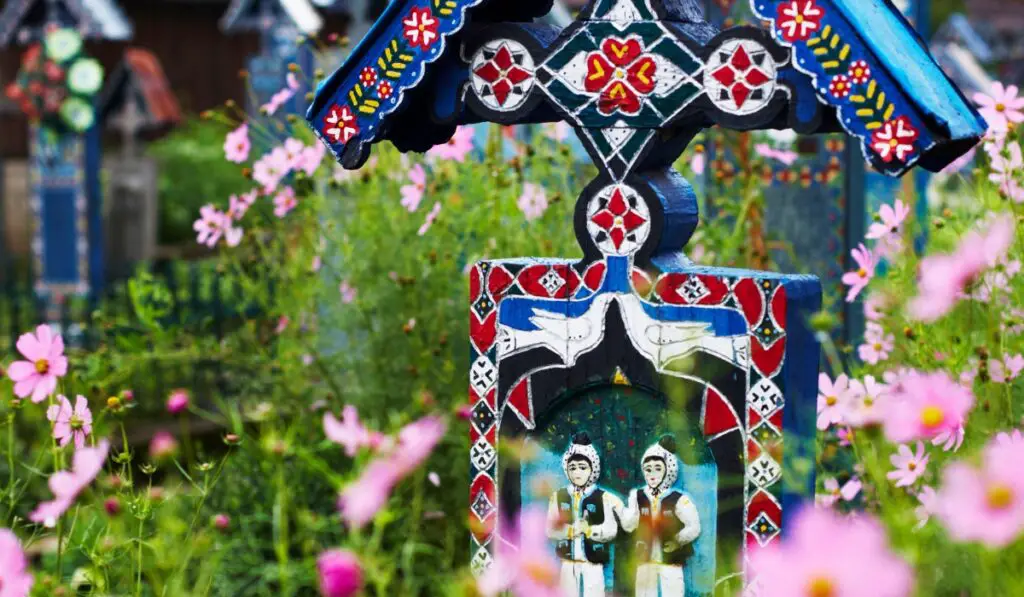This post may contain affiliate links. At no cost to you, purchases made through these links may result in a small commission for Traveling Transylvania. We never recommend products that we don’t know and trust. Thank you for your continued support!
Have you ever imagined a cemetery where departures are celebrated with a touch of humor and vibrant hues of deep blue? Welcome to the Merry Cemetery (or Cimitirul Vesel, as the locals fondly call it), nestled in the picturesque village of Săpânța, Maramureș county, just by the Ukrainian border in northern Romania.
Here, the age-old tradition of mourning takes a cheerful twist. Instead of melancholy gray tombstones, the Merry Cemetery greets you with illustrated crosses bursting with colors, and darkly humorous poems that reflect the lives and dirty details of the deceased. Not your typical resting place, and certainly not the typical memorial, this cemetery has carved a niche for itself as one of the most famous in Romania, and dare we say, the world.
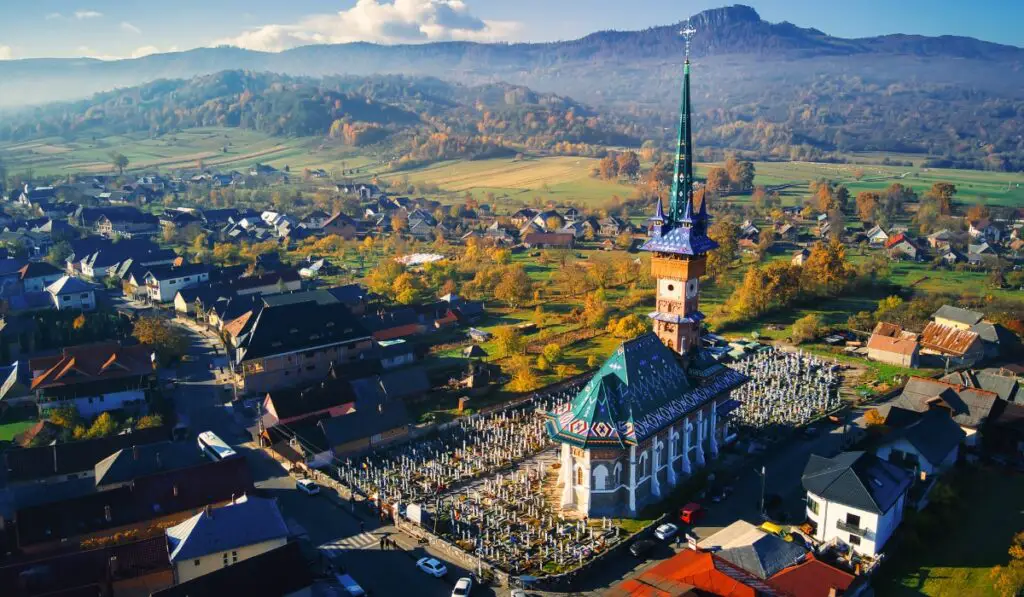
History of the Merry Cemetery
The intriguing saga of the Merry Cemetery begins in the year 1935. It was not born out of a commercial whim or a modern art experiment, but from the heart and hands of a folk craftsman and local artist named Stan Ioan Patras. He was the first person to infuse the sadness of goodbyes with humor and a light-hearted spirit in this manner. It’s said that his inspiration sprouted from the ancient Dacian culture, which celebrated life and chose to embrace death rather than mourn it.
As with most precious things, the Merry Cemetery was Romania’s best-kept secret for years. The world remained largely oblivious to its charm until the early 1970s. This all changed when a French journalist publicized this gem and spread the word about its vibrant and heartwarming ethos to the outside world.
Intricately carved from oak wood, each tombstone in the cemetery is a canvas of sweet stories. Today, the local cemetery boasts over 800 of these wild folk art masterpieces.
While one side of these crosses paints tales of the deceased’s life, the other side portrays, often with a humorous touch, the manner of their demise in a series of cheery pictures with careful symbolism. Some showed the deceased’s image, some clever or ironic poems, and one memorable grave showing a black skeleton dragging the deceased town drunk while he drinks from his bottle.
Stan Ioan Pătraș died in 1977. However, before his departure, he carved his own epitaph, encapsulating his life’s philosophy in a few poignant lines. Today, his legacy is upheld by his most talented apprentice, Dumitru Pop Tincu, who continues the tradition, ensuring that every epitaph written and each of the wooden crosses are as unique as the person’s life they represent.
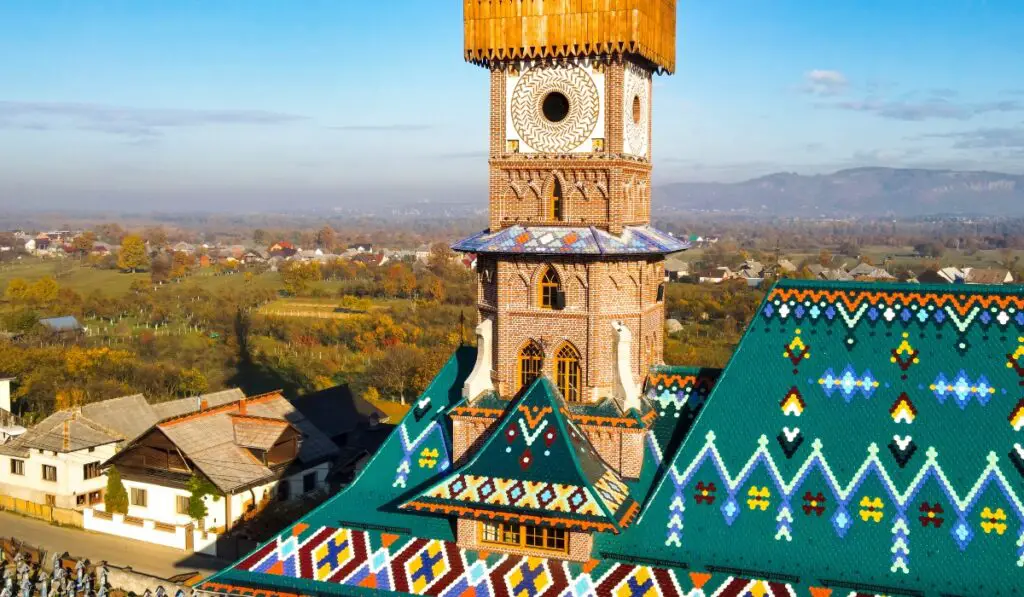
Significance of the Colorful Headstones
In a world where graveyards typically resonate with the solemn grays and melancholic whites, the Sapanta Merry Cemetery stands out with its riot of colored grave markers. But have you ever paused to wonder, why blue? This vibrant shade, which dominates the cemetery, isn’t a mere aesthetic choice; it holds deep-rooted cultural and spiritual significance.
The blue, often referred to as ‘Săpânța blue’, symbolizes hope, freedom, and the link between the skies and the heavens. Each tombstone, meticulously painted in this hue, becomes a bridge between the earthly realm and the eternal, reflecting the community’s beliefs in life after death.
Other colors have significance in the cemetery’s crosses as well. Yellow represented fertility, whereas green represented life.
The vivid illustrations and candid epitaphs are not just about adding humor. These wooden crosses serve as a testament to the deceased’s role in the community, their character, their memorable life episodes, and final moments. This approach strips away the generic nature of tombstones, transforming them into personal, tailor-made memorials.
While death is universal, the way it’s perceived varies across cultures. In Săpânța, the Merry Cemetery reflects a local belief system where death is a continuation of life, a passage, rather than an end. And these colorful tombstones? They’re the village’s heartfelt ode to the departed, ensuring they’re remembered not with tears, but with smiles and tales of their vibrant lives.
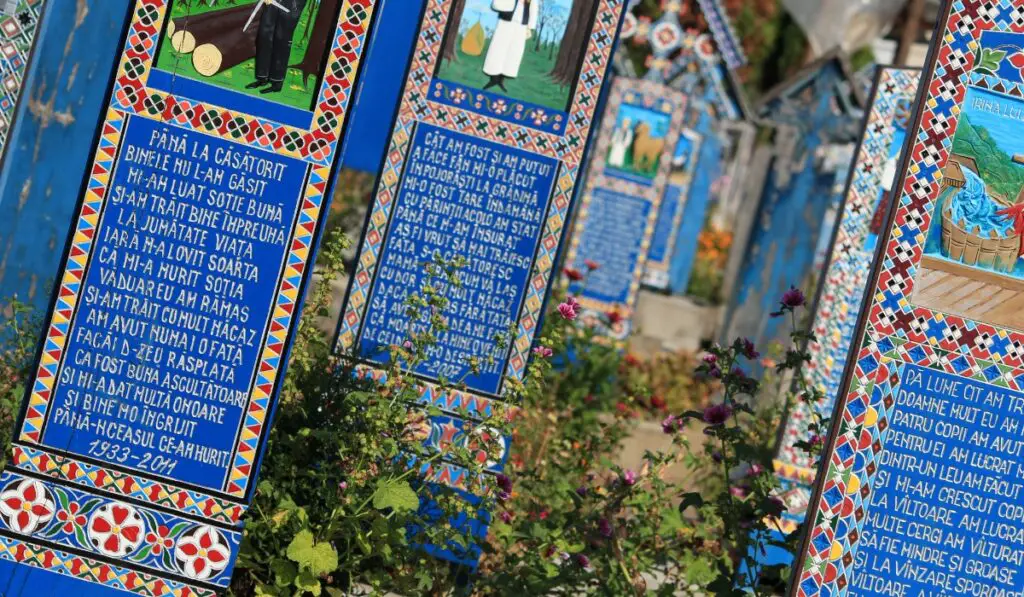
Funny Epitaphs: The Heart of the Merry Cemetery
Amidst the sea of cerulean at the Romanian Merry Cemetery, the epitaphs etched on the tombstones capture one’s attention, spill a few secrets and often elicit a hearty laugh. These aren’t your regular solemn farewells; they are the soulful, humorous, and at times, cheeky adieus that encapsulate the essence of the deceased’s true life.
One famous epitaph reads:
Underneath this heavy cross
Lies my poor mother-in-law
Three more days she would have lived
I would die, and she would read (this cross)
You, who here are passing by
Not to wake her up please try
For if she comes back home
She’ll criticize me even more
But I will behave so well
That she won’t return from hell
Stay here, my dear mother-in-law.
This epitaph, in its playful tone, gives us a humorous glimpse into everyday real life, relationships, and the quirks of the individual, all while being framed within the universal theme of life and death.
The creator of the Merry Cemetery, Stan Ioan Pătraș was not one to shy away from the tradition he began. He actually carved his own cross, poignantly reminiscing:
Ever since I was a little kid
Stan Ion Pătraș was my name
Listen to me, my good people
Because I will tell no lie
All the days I have lived
I wished no harm to anyone
Only good, as much as I could
No matter for whom
Oh, this poor world of mine
Living through it was so hard.
But it’s not just about humor. These epitaphs serve as mirrors, reflecting the genuine tales, the triumphs, the trials, and the quirks of Săpânța’s residents. Dumitru Pop, the current keeper of this tradition, emphasizes authenticity. In his words, families desire the “real truth” to be depicted, wanting the stories to be as unique as the individuals they commemorate.
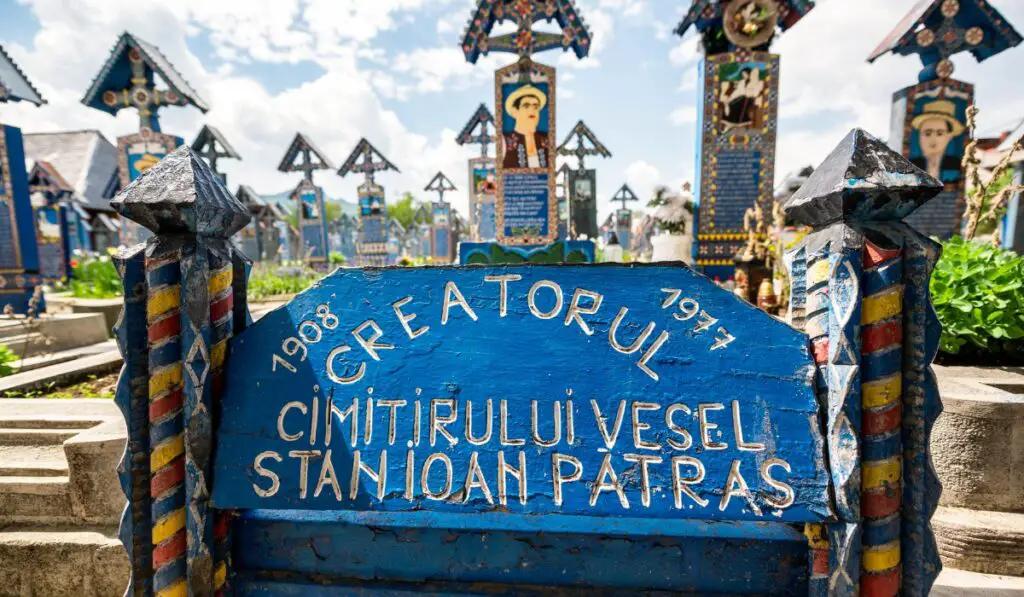
Visiting the Merry Cemetery: A Unique Experience
Stepping into the Merry Cemetery of Săpânța is more than just a stroll through tombstones; it’s an immersive journey into the heart of a community, its beliefs, and its unique take on life and death. Here’s what you can expect and some tips to make the most of your visit:
Experience the Vibrant Artistry
Upon entering, your senses will be greeted by a kaleidoscope of colors, predominantly the iconic ‘Săpânța blue’. Each tombstone, crafted from oak wood, stands as a testament to the craftsmanship passed down through generations. The carvings, although humorously depicted, are detailed, showing the deceased in various life activities or, at times, the manner of their passing.
Learn of Stories That Speak
While the art catches the eye, it’s the epitaphs that capture the heart. As you walk among the graves, take the time to read the stories. They paint a vivid picture of the life, loves, quirks, and even the misadventures of the deceased. From tales of love and loss to cheeky anecdotes, each epitaph tells a unique story.
Stop by the Stan Ioan Pătraș House-Museum
A visit would be incomplete without stopping by the house of the mastermind behind the Merry Cemetery. The home of Stan Ioan Pătraș has been transformed into the Merry Cemetery’s Workshop museum. Here, they offer insights into the life and works of the talented craftsman. Inside, you’ll find original tools, photographs, and some of his earliest tombstone creations.
Respect the Cemetery
While the atmosphere is light-hearted, remember it’s still a cemetery. Always show respect, walk along the designated paths, and avoid touching the tombstones or carvings.
Practical Information
Location on Google Maps: Merry Cemetery in Romania
Visiting hours are from 10:00 to 18:00 daily. An adult entry ticket is priced at 4 Lei, while children can enter for 2 Lei. If you’re keen on capturing memories, there’s a photography fee of 4 Lei and a filming fee of 10 Lei.
A visit to the Merry Cemetery in Săpânța, Romania, is a deep dive into a blend of culture, tradition, art, and a community’s unique perspective on life’s inevitable cycle. It’s not just a tourist spot; it’s an emotion, a celebration of life in the face of death.
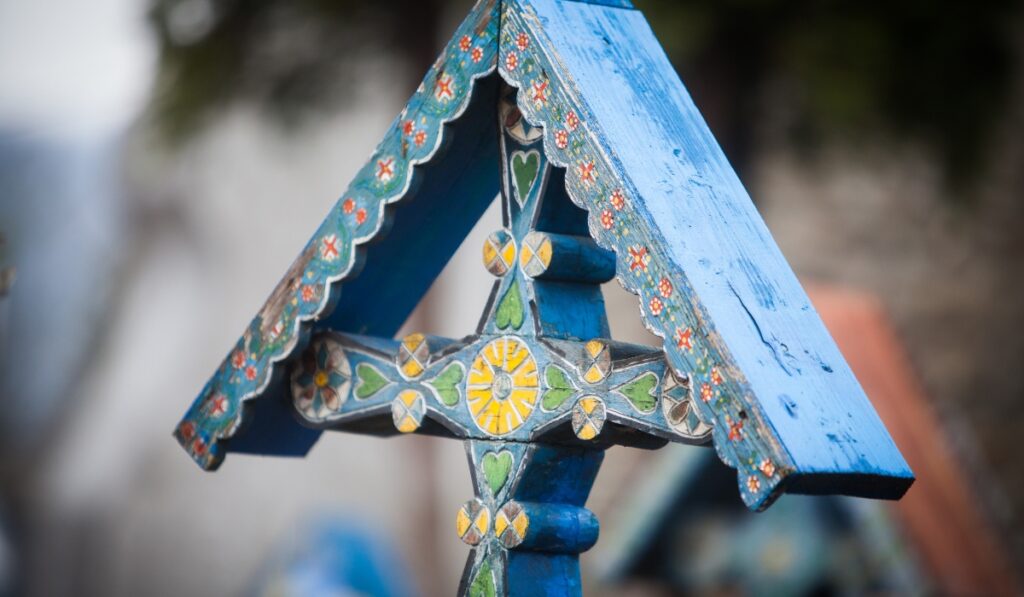
Embracing Life in the Heart of Death
In a world where the mention of cemeteries often evokes images of somber headstones, the Merry Cemetery stands as a beacon of life’s celebration amidst its inevitable end. It’s more than just a graveyard. It’s a canvas where stories of the departed continue to live, narrated with humor, respect, and a touch of cheekiness.
This charming local cemetery is a testament to the small town of Săpânța and its indomitable spirit. From the vivid blues that symbolize hope and the heavens, to the authentic epitaphs that encapsulate entire lifetimes, the Merry Cemetery is a poignant reminder that death isn’t an end but merely a transition.
In visiting, one doesn’t just witness a tourist attraction but partakes in an age-old tradition, an art form, and most importantly, a unique philosophy. It beckons us to remember that while life is fleeting, memories and legacies endure.
So, when you think of Transylvania and its myriad attractions, let the Merry Cemetery remind you of the vibrant tapestry of life, love, humor, and the shared human experience that binds us all. And don’t forget to check out the Wooden Churches of Maramures and the adorable village of Breb while you’re in the area!

